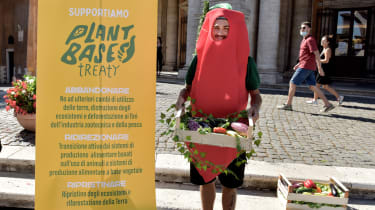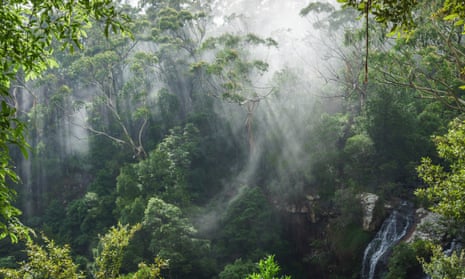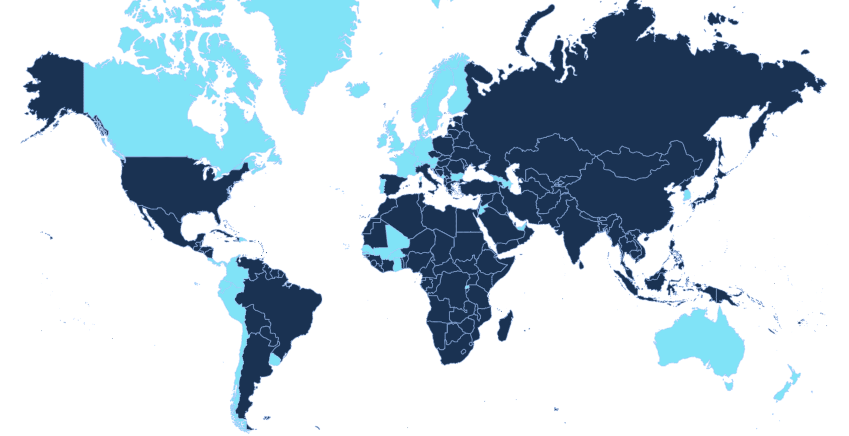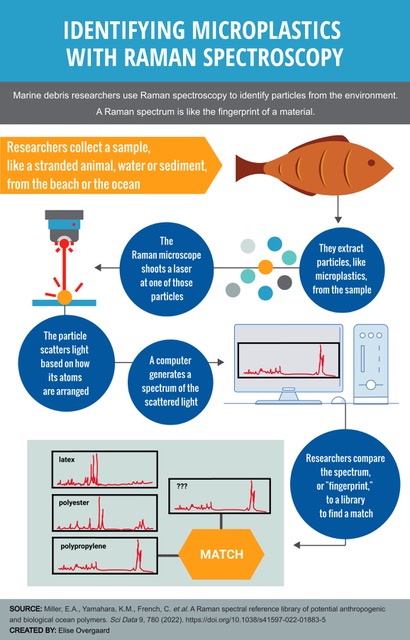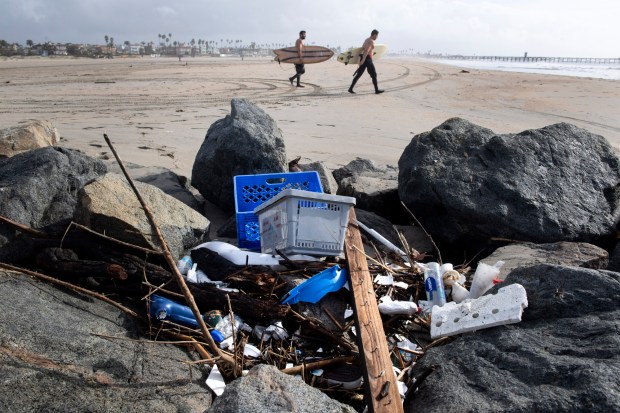Critics are describing the Biden administration’s opening position in a United Nations effort to reach a global treaty or agreement to end plastic waste as vague and weak, despite its recognition of a need to end plastic pollution by 2040.
The proposal, for example, calls for individual national action plans as opposed to strong global mandates.
It does not seek enforceable cuts in plastics manufacturing, even though reducing plastic production was a key recommendation of the landmark 2021 National Academies of Sciences, Engineering and Medicine report on the devastating impacts of plastic pollution.
The U.S. proposal touts the benefits of plastics and calls for improved management of plastic waste such as re-use, recycling and redesigning plastics, which are positions similar to recommendations from the chemical and plastics industries.
Made public earlier this month, the U.S. position contrasts sharply with submissions representing dozens of other countries that are part of a “high ambition” coalition including members of the European Union. Those differences reveal deep divisions among some of the 160 nations working to solve a problem the United Nations describes as a triple planetary crisis of climate change, nature loss and pollution.
And with the second negotiation session scheduled for late spring in Paris, scientists, along with environmental organizations, are making a case that too much is at stake for a weak agreement to come out of U.N. negotiations launched last year amid a global recognition that the world is choking on so much plastic that it threatens its very habitability.
“The U.S. (proposal) is underwhelming, to say the least,” said Bethanie Carney Almroth, an ecotoxicology professor at Sweden’s University of Gothenburg, and member of the interim steering committee of a new group, Scientists’ Coalition for an Effective Plastics Treaty, which formed last year. She studies chemicals and particles in the environment, including the microplastics that have become ubiquitous throughout the world, and even in human feces and blood.
Among Almroth’s concerns, the U.S. proposal would rely on national action plans, much as the 2015 Paris agreement does for greenhouse gas emissions blamed for causing climate change.
Some critics argue that the Paris agreement relies too much on collective action without enough incentives or penalties to make sure countries meet their commitments. A U.N. report last year found that individual country pledges to reduce greenhouse gas emissions put the planet on a path to heat between 2.1 and 2.9 degrees Celsius, well beyond the Paris goal of 1.5 degrees, ensuring further climate chaos.
“If that’s where we are going (with plastics), that’s not going to solve any problems,” Almroth said of the plastics challenge. “This is a very international problem … from fossil fuels all the way through the production lines, all the way through our consumerism, all the way through waste, exports and transportation. If we don’t make a global tool to address that, we’re going to fail. And when I say fail, I mean, destroy the planet and make it unlivable for humans.”
State Department officials declined to comment, instead referring to a written statement made in December by Monica Medina, assistant secretary of state, following the first round of negotiations in Uruguay.
“The world is drowning in plastics,” Medina conceded. “This is a crisis for people and nature, and one that is only getting worse.”
But, she said, a “country-driven approach should strengthen ambition. And it should foster innovation over time. Let’s avoid the temptation to impose one-size-fits-all measures that drive down our ambition.”
‘High Ambition’ Coalition Raises the Bar
In all, the United Nations has collected more than 60 opening submissions from participating countries, and another 200 written comments from non-governmental organizations, including environmental and business groups, in advance of a second negotiation meeting to be held in Paris May 29 through June 2. Last March, at a United Nations Environmental Assembly meeting in Kenya, countries agreed to work toward achieving a global plastics agreement within two years.
Some of the countries’ opening proposals are strong and expansive. The European Union, for example, calls for global targets to reduce the production of plastics. The E.U. and other countries articulate their vision for phasing out risky chemical additives, such as endocrine disruptors like phthalates, which are used to make plastics pliable and are a threat to human health.
The 40-member High Ambition Coalition to End Plastic Pollution, led by Norway and Rwanda, offered a proposal that notes plastic consumption has quadrupled over the past 30 years and that plastic production would likely double over the next 20. Measures and targets for limiting plastic production will be needed to “reduce pressure on the environment globally,” they wrote.
“Each (country) should be required to take effective measures to reduce the production of primary plastics polymers to an agreed level to reach a common target,” the coalition recommended.
The coalition also wrote that curbing the manufacturing of plastics “will complement efforts to reduce greenhouse gas emission.”
That Norway, a fossil fuel-producing nation, endorses the concept of limiting plastic production is significant, said Vito Buonsante, an environmental lawyer and technical and policy advisor at the International Pollutants Elimination Network, or IPEN, whose submission argues that chemical production and plastic pollution threaten the stability of the global ecosystem.
“We shouldn’t forget that the main problem here is that there’s way too much plastic,” Buonsante said. “And if we don’t slow down the amount of plastic that is produced, that is going to be problematic.”
Because it has a lot of diplomatic weight to throw around, whatever the United States proposes gets a lot of attention.
“The U.S. has quite a footprint on this process,” said Jane Patton, campaign manager for plastics and petrochemicals for the Center for International Environmental Law, a group advocating for “globally mandatory provisions establishing control measures” and a treaty structure “covering all stages of the full lifecycle of plastics” from fossil fuel extraction to waste management, “with obligations and control measures” in each of the stages.
The U.S. is also a major global plastics producer and leads the world in the generation of plastic waste.
“Many of the most powerful corporate plastic producers are based in the United States and they have quite a significant sway over the U.S. government,” she said.
‘Circularity’ Sounds Good, But May Just Be Spin
The U.S. submission contains lofty language. For example, it says the Biden administration supports an objective “focused on the protection of human health and the environment from plastic pollution” and an agreement that includes “legally binding obligations,” such as creating and updating national action plans and national reporting, as well as other “commitments and voluntary approaches.”
The agreement, according to the U.S. delegation, should be designed to prevent and reduce the amount of plastic pollution entering the global environment and promote the sustainable production and consumption of plastic.
Countries would be obligated to show progress and submit new plans on a time schedule, say every five years, according to the U.S. proposal.
Fossil fuel or plastic-producing countries like the United States, China and Saudi Arabia, tended in their submissions to emphasize waste management and national planning.
“The control measures of the (agreement) should focus on managing the leakage of plastic waste to the environment,” China’s submission said. “National action plans are essential for countries to develop national strategies based on their national circumstances to address plastic pollution domestically and contribute to the global efforts.”
The Saudi submission, echoing Medina’s December statement, said “there is no one size and no common standards that fit all as individual countries.”
The U.S. named extended producer responsibility programs as a potential solution. These programs can make producers responsible for offsetting the environmental impacts of their products and packaging. But the environmental group Beyond Plastics warns that unless they are designed correctly, they lack teeth and will fail.
Buonsante said he appreciated U.S. language around the need to protect public health in any global plastics agreement.
Keep Environmental Journalism Alive
ICN provides award-winning climate coverage free of charge and advertising. We rely on donations from readers like you to keep going.
Donate Now
But the way the U.S. framed its proposal, “it doesn’t seem there would be any consequences if countries don’t meet their obligations, whatever they are, in their national action plans,” he said.
The U.S. and many countries, along with industry, rely heavily on the term “circularity” in their proposals. It’s become a buzzword adopted by industry, countries and even some environmental groups to suggest an economy or products based on reuse instead of continuing extraction of natural resources like fossil fuels to make plastics. But it can also be used for greenwashing, or marketing spin, to make something sound better for the environment than it really is.
“Circularity is something that is an aspiration,” Buonsante said. “But it doesn’t have any concrete or common understanding of what that means.”
With plastics, questions of circularity are particularly problematic, he said, because plastic products are made with thousands of chemical additives, many of them toxic, complicating and even contaminating recycling processes. IPEN published a report last year titled, “How plastics poison the circular economy,” calling for public policies to end the recycling of hazardous chemicals found in plastics.
“Circularity is incredibly dangerous” with plastics, “because of the safety and sustainability issues are not only not worked out, they are not acknowledged,” said Terry Collins, a professor of green chemistry at Carnegie Mellon University, and another member of the Scientists Coalition for an Effective Plastics Treaty.
Collins said that there is “an avalanche of evidence” that some chemicals used in plastics disrupt endocrine systems in the human body.
These “disruptors are wrecking us,” he said, “but the government is simply unable to address this issue.”
Recycling Has Failed, But Business Groups Still Push it
In their submissions, business groups are urging that the agreement recognize the benefits of plastics and bolster recycling policies, even though recycling for most plastics has largely been a global failure. Globally, only 9 percent of plastic waste is successfully recycled, according to the Organization for Economic Co-operation and Development, a group that represents developed nations.
The Plastics Industry Association and the U.S. Chamber of Commerce, for example, urged countries in their joint submission to avoid “arbitrary” bans and “advance policies that help create a circular economy, such as promoting widespread adoption of mechanical and advanced recycling technologies.”
Advanced recycling is a term often used to mean chemical recycling, where, ideally, technology such as pyrolysis or gasification would turn plastic waste into fuel or feedstocks for new plastics. But scientists and environmentalists who have studied the largely unproven technology say it is essentially another form of incineration that requires vast stores of energy, has questionable climate benefits and puts communities and the environment at further risk from toxic pollution.
A recent study by the National Renewable Energy Lab in Colorado referenced research showing that, with pyrolysis and gasification, much of the waste plastic is lost in the process. In fact, the researchers found only 1 to 14 percent of the plastic sent through those processes is retained as plastic, which critics say makes it hard to describe those processes as recycling.
The Business Coalition for a Plastics Treaty, which includes companies such as Coca-Cola (named by a coalition of environmental groups as the “world’s top plastics polluter”), Pepsico, Unilever and Walmart, submitted comments that acknowledged “most plastics are not designed for a circular economy nor are they circulated in practice.” But the coalition insists that “the best available scientific analysis shows us that known circular economy solutions, if applied at scale, can reduce annual volumes of plastic pollution by at least 80 percent by 2040 compared to business-as-usual and achieve near-zero plastic pollution by 2060 globally.”
A Coca-Cola spokesman did not respond to questions posed by Inside Climate News.
The International Council of Chemical Associations offered a defense for chemical additives to plastics, while claiming there’s little evidence that microplastics are harmful. Plastics, the group wrote, are a solution to climate change because plastic food packaging keeps food fresher longer and limits food waste that contributes to climate change, and plastic makes cars lighter and more fuel efficient.
“We must recognize that plastics, and the chemical additives contained within, are a critical element to achieving the circular economy with the lowest carbon impact,” ICCA wrote.
Both the International Council of Chemical Associations and the American Chemistry Council did not respond to requests for comment.
Scientists Form a Plastics Truth Squad
As the process moves along, one of the challenges for delegates will be to navigate complicated and evolving science.
That is where the new scientists’ group, with more than 500 members, can play an important role, working with receptive national delegations, said Almroth, the University of Gothenburg professor.
One way, she said, is to help people avoid confusion or miscommunication over terms like circularity. “I’m a bit cynical sometimes with how some bad actors can behave in these situations,” she said. But “there’s potential for people kidnapping terminology or purposefully misleading people.”
The stakes to people and the planet also need to be clear, she said.
“I can be accused of being hyperbolic,” Almroth acknowledged. But she said she’s been working with other scientists on what’s called the planetary boundaries framework, and they have found plastics along with other toxic chemicals are now way outside what they’d call a “safe operating space” for the Earth and its ecosystems.
It’s not, she said, that the “planet is going to die or cease to exist. We’re just saying that we’re moving into a new system that’s much more unpredictable and much more inhospitable for our species. And we do see that plastics are connected to a lot of the shifts that are happening on a planetary scale.
“There are also connections to plastics and human rights issues, to human health issues, to reproductive issues, and to child development,” she said. “So across the board, there are problems and they’re going to get worse.”
James Bruggers
Reporter, Southeast, National Environment Reporting Network
James Bruggers covers the U.S. Southeast, part of Inside Climate News’ National Environment Reporting Network. He previously covered energy and the environment for Louisville’s Courier Journal, where he worked as a correspondent for USA Today and was a member of the USA Today Network environment team. Before moving to Kentucky in 1999, Bruggers worked as a journalist in Montana, Alaska, Washington and California. Bruggers’ work has won numerous recognitions, including best beat reporting, Society of Environmental Journalists, and the National Press Foundation’s Thomas Stokes Award for energy reporting. He served on the board of directors of the SEJ for 13 years, including two years as president. He lives in Louisville with his wife, Christine Bruggers.

